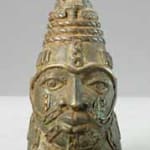Benin Brass Bell, 1700 CE - 1897 CE
Brass
3 x 5.75
PF.3268a
Further images
Brass bells, like rattle-staffs, are an essential feature of Benin ancestral altars--whether for kings, chiefs, or wealthy commoners. Several bells are placed along the front of each altar, and they...
Brass bells, like rattle-staffs, are an essential feature of Benin ancestral altars--whether for kings, chiefs, or wealthy commoners. Several bells are placed along the front of each altar, and they are rung in order to summon the ancestors to hear the prayers of their descendants and to partake of the offerings made at the altar. The more elaborate or unusal the form or decoration of the bell, the higher the rank of the altar it is placed upon. Small brass bells, such as this one, were also worn by chieftans--the sound of the bells announced chieftans' arrival or appearance. This marvelous brass bell is intricately sculpted and decorated. Such elaborate depiction of a face and symbolic marks suggests that this conical bell was placed on the highrank of an altar, or was worn by an important chieftain. The face is carefully modeled with details, and the cone-shaped headdress forms the top portion of the bell with a handle. Moreover, mysterious designs, patterns, and motifs enhance the ancient sculpture. The face is marked with double lines which enclose small circular shapes, and a braid-pattern marks the center of the forehead. Such beautifully sculpted face looks regal that as we look into the sculpture, we wonder who this bell represents. Mysterious figures such as snakes, frogs, and a human (who seems to be holding something) fill the space below the face. The skillful and intricate artistry of this ancient bell amazes the viewers today. And although we may not be able to decipher the meaning of specific symbols and signs of the bell, we still appreciate its incredible, timeless beauty.







